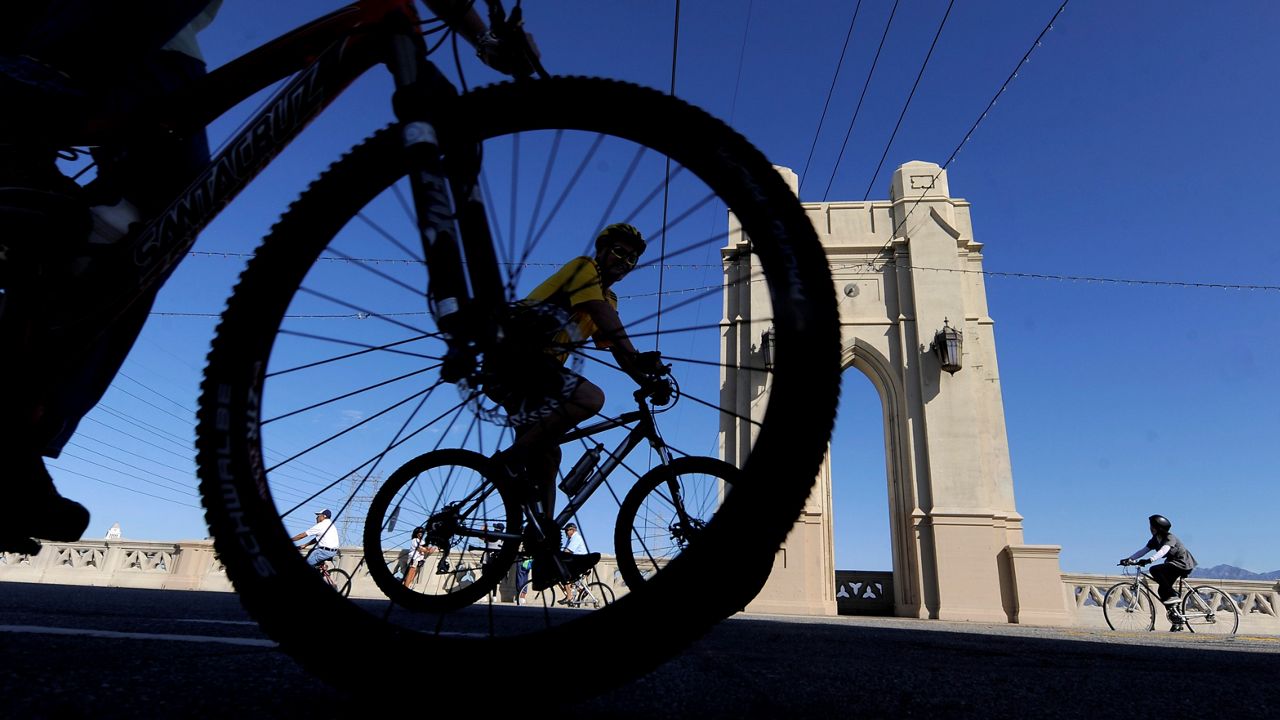LOS ANGELES (CNS) — A measure that would fast-track implementation of Los Angeles’ ambitious mobility plan will come before voters in 2024, after the City Council voted to place it on the ballot Wednesday.
Frustrated by what they see as a lack of progress on Mobility Plan 2035 — approved by the council in 2015 — a coalition of climate, transportation, business and labor groups led by Streets for All collected enough signatures and forced the city to take action on a petition.
The mobility plan called for large-scale construction of bike lanes, pedestrian routes and other street improvement measures to make Los Angeles roads less car-centric. Seven years later, the city has implemented just 3% of the plan’s 1,500 miles of pedestrian safety improvements.
“I’m embarrassed and ashamed that since 2015, we’ve only been able to build 3% of the mobility plan,” Council President Nury Martinez said. “That is shameful.”
The Healthy Streets LA ballot measure would require the city to implement the applicable enhancements described in Mobility Plan 2035 whenever it paves or modifies at least 660 feet of a street. The city would have to provide updates on implementation of the plan on a website or open data portal. The ordinance would allow for anyone to sue the city if it doesn’t comply.
“Unfortunately, the city really understands the language of lawsuits,” Michael Schneider, the founder of Streets for All, told City News Service. “We don’t want to sue the city. Our goal isn’t to get rich or to have lawyers get rich. But we needed something with teeth. Some enforcement mechanism that the city would understand and the city would want to avoid.”
The council unanimously approved a framework in June calling for more coordination between city agencies to ensure more efficient implementation of the plan’s various parts, and for a prioritization of improvements in low-income neighborhoods that have traditionally had a higher percentage of the city’s most dangerous thoroughfares.
The proposal was put forward by Martinez as it became apparent that the ordinance would soon come before the council. Council members generally supported the ordinance, but said the council action provided more strategy, framework and equity in enacting the mobility plan.
“The council-led motion would ensure that the city implements the mobility plan in an equitable way,” Martinez said. “And equity has to be at its core.”
Instead of adopting the ordinance immediately, the council voted 13-0 on Wednesday to place it on the 2024 ballot. Proponents of adopting the ordinance immediately say two years is too long to wait.
“Every 30 hours, someone is injured or killed by traffic violence, and a pedestrian is killed once every three days,” Schneider told CNS. “It’s not an exaggeration to say that literally every day that we wait, it’s hurting somebody. So we don’t want to wait a year and a half for safer streets.”
Even with the approval of the mobility plan, Los Angeles has seen a 20% increase in traffic deaths over the past year, despite the city’s goal of eliminating traffic deaths by 2025 through the Vision Zero initiative. According to Martinez’s office, 294 people were killed in traffic incidents last year, including 132 pedestrians.
The city Department of Transportation formulated a High Injury Network map that shows the deadliest streets in the city, responsible for 70% of deaths and severe injuries, are in “working-class neighborhoods” of South Los Angeles, Central Los Angeles and the northeast San Fernando Valley.
The framework would select corridors for improvements and establish standard elements that can be implemented to make the routes safer for pedestrians, cyclists and transit riders.
Schneider said it is “tragic” that citizens had to spend money and resources “not for their own plan, just to get the city to implement its own plan that they said they wanted.”
“It’s kind of absurd that we live in a place where that’s needed,” Schneider said. “It’s such a waste of money and time, and resources that could be spent in other ways. But it is what it is. That is where we live. So we’re playing the game.”
Many transportation advocates attended Wednesday’s council meeting. Some supported adopting the motion immediately, while others wanted to send it to the ballot.
“I cannot support this manufactured rush to adopt a policy that still needs much more love and work,” said John Yee, executive director of Los Angeles Walks.
Yee said the ballot measure focuses on the city’s street resurfacing program, “which is failing working class Angelenos and transit riders.”
Eli Akira Kaufman, executive director of the Los Angeles County Bicycle Coalition, said in a statement that equity is the keyword.
"Once the goals of the Healthy Streets LA measure pass, whether by the will of the people in 2024 or through the Council President's motion, our focus must be on investing in a process that is rooted in equity and ensures all Angelenos enjoy equal access to dignified mobility options no matter their zip code," Kaufman said.
Martinez and council members welcomed the petition, pledging to hold themselves accountable to speed up the enactment of the Mobility Plan.
“We’re quick to put accountability on other people,” Councilman Marqueece Harris-Dawson said. “Where’s our accountability? Where’s ours?”
The remarks were met with a round of applause.
Councilwoman Nithya Raman added that it was exciting and inspiring to see so many people advocating for more bike- and pedestrian-friendly roads.
“I think it’s really important to mark this as a change in Los Angeles,” Raman said. “I know there’s a lot of cynicism out there about the capacity of the city to implement the change that this ballot measure wants us to implement. And I’m excited to see whether we can match the urgency that I’m hearing from all of you today.”



